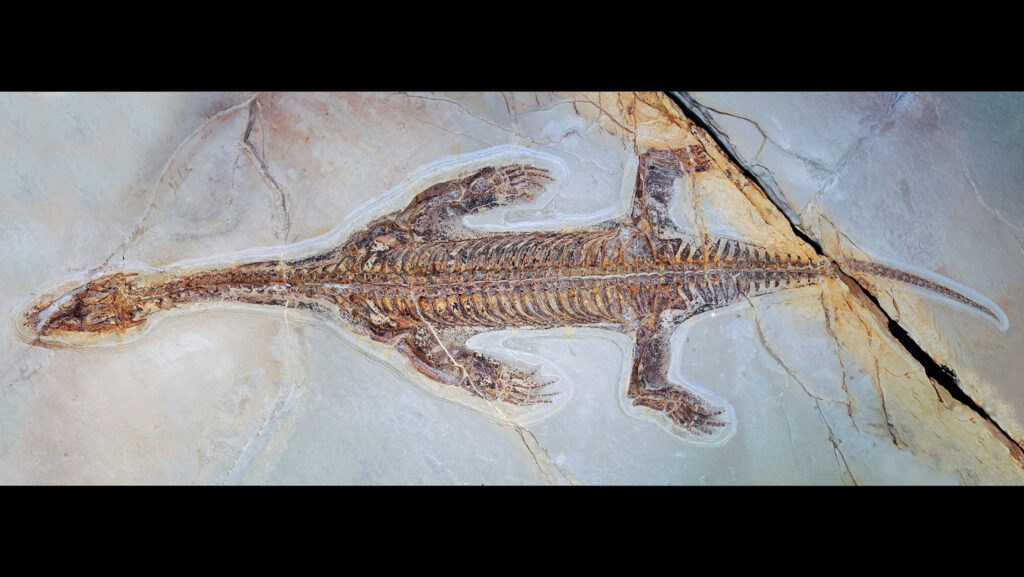New insights into an ancient swimming reptile are more than skin deep.
An analysis of a 240-million-year-old fossil, published August 29 in the Swiss Journal of Palaeontology, offers clues to how a reptile similar to those that evolved into the Mesozoic’s iconic and long-necked “sea monsters” — plesiosaurs — adapted to life underwater. The specimen is the first of its kind with fossilized skin and scales.
“I saw the paper when it came out and was amazed by the specimen,” says Sven Sachs, a paleontologist at the Natural History Museum in Bielefeld, Germany, who was not involved with the study. “Fossilized soft tissue is rarely preserved in [early aquatic reptiles], but here it is so complete that the body outlines are visible and even the pattern of the skin and some of the muscles can be reconstructed.”
The new specimen belongs to a species called Lariosaurus valceresii. This small aquatic reptile evolved shortly after the Permian mass extinction, which killed around 90 percent of ocean life and 70 percent of terrestrial vertebrate life 252 million years ago.
“Reptiles thrived in the seas very soon after the crisis,” says paleontologist Silvio Renesto at the University of Insubria in Italy. Oceans after the extinction event contained few competitors and plenty of food, which enabled small reptiles to infiltrate the empty waters and proliferate into myriad new species, he says.
Researchers unearthed the fossil in 2023 from Monte San Giorgio, a UNESCO World Heritage Site in the Alps that divides Switzerland and Italy. The mountain holds rock outcrops dating to shortly after the mass extinction. At the time, the area was a tropical lagoon with poor water circulation and bacterial mats that produced hard minerals. This environment created low-oxygen conditions rich in chemicals that could preserve dead animals while also preventing scavengers and other biota from eating away animal tissues. This encouraged the occasional preservation of skin and other soft tissues in animals that died and sank to the bottom of the lagoon.
Researchers have uncovered other fossils with soft tissue at Monte San Giorgio, including fish with preserved internal organs and an ichthyosaur with skin, fins and connective tissues.
To better understand the new fossil, Renesto and his colleagues took high-resolution photographs and detailed measurements and scrutinized its underlying chemical composition with a scanning electron microscope.
Some of the fossil’s highly preserved features contradict previous hypotheses about L. valceresii, Renesto says. Researchers have assumed its hands were embedded within flippers. The new fossil shows the reptile instead had partially webbed hands and feet with exposed fingers and toes. The fossil also shows much of the body was covered in scales, unlike plesiosaurs, which had only scaled limbs. The skin enabled researchers to infer that L. valceresii had “extremely robust” musculature in the forearms, hinting at how it might have moved through water.
“It is clear that this species was using its limbs to propel itself,” says Miguel Marx, a paleontologist at Lund University in Sweden not involved with the study. The reptile rowed its arms like a seal rather than propelling itself forward with a powerful tail like crocodiles, he says. “It is also informative regarding how the ancestors of other successful groups, like plesiosaurs, may have appeared and swam before evolving flippers for underwater flying.”
Renesto agrees, adding that the finding helps show limbs were more important than other methods of swimming.
The new discovery is “extraordinary,” Marx says. “Bones don’t really give us a clear idea of what ancient animals would have looked like when alive like fossilized tissues do, and that’s why they are so precious.”
Read the full article here


